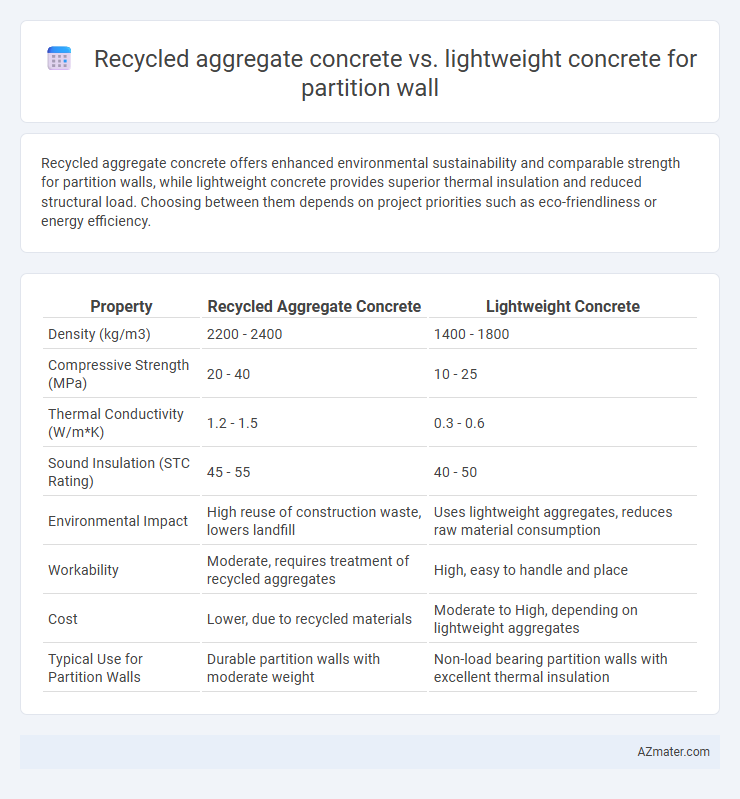Recycled aggregate concrete offers enhanced environmental sustainability and comparable strength for partition walls, while lightweight concrete provides superior thermal insulation and reduced structural load. Choosing between them depends on project priorities such as eco-friendliness or energy efficiency.
Table of Comparison
| Property | Recycled Aggregate Concrete | Lightweight Concrete |
|---|---|---|
| Density (kg/m3) | 2200 - 2400 | 1400 - 1800 |
| Compressive Strength (MPa) | 20 - 40 | 10 - 25 |
| Thermal Conductivity (W/m*K) | 1.2 - 1.5 | 0.3 - 0.6 |
| Sound Insulation (STC Rating) | 45 - 55 | 40 - 50 |
| Environmental Impact | High reuse of construction waste, lowers landfill | Uses lightweight aggregates, reduces raw material consumption |
| Workability | Moderate, requires treatment of recycled aggregates | High, easy to handle and place |
| Cost | Lower, due to recycled materials | Moderate to High, depending on lightweight aggregates |
| Typical Use for Partition Walls | Durable partition walls with moderate weight | Non-load bearing partition walls with excellent thermal insulation |
Introduction to Partition Wall Materials
Partition walls commonly utilize recycled aggregate concrete and lightweight concrete due to their specific material properties. Recycled aggregate concrete offers enhanced sustainability by incorporating construction waste, providing good compressive strength and durability for non-load-bearing partitions. Lightweight concrete, characterized by its lower density and thermal insulation capabilities, effectively reduces dead load and improves energy efficiency in interior wall applications.
Overview of Recycled Aggregate Concrete
Recycled aggregate concrete (RAC) incorporates crushed concrete debris as a substitute for natural coarse aggregates, offering an eco-friendly alternative that reduces construction waste and conserves natural resources. Its density typically ranges from 2200 to 2400 kg/m3, providing sufficient structural strength and durability for partition walls while enhancing sustainability in building practices. RAC exhibits comparable compressive strength to traditional concrete, making it a viable choice for non-load bearing partition walls where environmental impact is a consideration.
Overview of Lightweight Concrete
Lightweight concrete is a specialized type of concrete designed with low-density aggregates such as expanded clay, shale, or pumice to reduce structural weight while maintaining sufficient strength for partition walls. It offers superior thermal insulation and fire resistance compared to recycled aggregate concrete, making it ideal for energy-efficient building designs. Additionally, lightweight concrete improves sound insulation and allows for easier handling and faster construction in partition wall applications.
Sustainability and Environmental Impact
Recycled aggregate concrete significantly reduces construction waste and conserves natural resources by incorporating crushed concrete from demolished structures, lowering the carbon footprint compared to traditional materials. Lightweight concrete, often made with expanded clay or shale, enhances thermal insulation and reduces structural load, contributing to energy efficiency but typically involves energy-intensive manufacturing processes. Choosing recycled aggregate concrete for partition walls offers superior sustainability benefits by promoting circular economy practices and minimizing environmental degradation.
Structural Performance Comparison
Recycled aggregate concrete (RAC) exhibits higher density and compressive strength compared to lightweight concrete (LWC), making it more suitable for partition walls requiring enhanced load-bearing capacity. LWC offers superior thermal insulation and reduced dead load, which benefits structural efficiency but may compromise impact resistance and sound insulation. The choice between RAC and LWC for partition walls depends on balancing strength requirements with weight reduction and thermal performance priorities.
Thermal and Acoustic Insulation Properties
Recycled aggregate concrete offers moderate thermal insulation with a density that provides better sound absorption, making it suitable for partition walls requiring enhanced acoustic performance. Lightweight concrete excels in thermal insulation due to its lower density and higher porosity, significantly reducing heat transfer compared to conventional concrete types. In partition walls, lightweight concrete typically outperforms recycled aggregate concrete in thermal insulation, while recycled aggregate concrete can provide competitive acoustic damping benefits.
Construction and Workability Differences
Recycled aggregate concrete (RAC) offers higher density and compressive strength compared to lightweight concrete, making it suitable for load-bearing partition walls but requiring more effort in mixing and handling due to its irregular aggregate shape. Lightweight concrete, characterized by lower density and enhanced thermal insulation, provides easier workability and faster installation for non-load-bearing partitions, attributed to its uniform, porous aggregates. The choice between RAC and lightweight concrete in partition wall construction hinges on balancing structural demands with ease of application and thermal performance.
Cost Analysis and Economic Considerations
Recycled aggregate concrete offers significant cost benefits in partition wall construction due to the lower price of recycled materials compared to traditional aggregates, reducing overall material expenses by up to 20%. Lightweight concrete, while typically more expensive per cubic meter, provides savings in structural support and labor costs because of its reduced weight, leading to lower foundation requirements and faster installation. Economic considerations must balance initial material costs against long-term savings from weight reduction and sustainability incentives, making recycled aggregate concrete more appealing for budget-sensitive projects and lightweight concrete preferable for applications prioritizing ease of handling and energy efficiency.
Durability and Maintenance Requirements
Recycled aggregate concrete offers enhanced durability with high resistance to environmental degradation and lower maintenance needs due to its robust composition and recycled materials that improve long-term performance. Lightweight concrete provides good durability but tends to have higher maintenance requirements, such as moisture control and potential surface repairs, due to its porous structure. For partition walls, recycled aggregate concrete ensures superior longevity and reduced upkeep compared to lightweight concrete options.
Recommended Applications for Partition Walls
Recycled aggregate concrete offers superior environmental benefits and enhanced load-bearing capacity, making it recommended for partition walls requiring durability and structural strength in commercial and industrial buildings. Lightweight concrete is preferred for partition walls in residential and office spaces where thermal insulation and ease of installation are prioritized due to its reduced density and improved acoustic properties. Both materials are suitable for partition walls, but application selection depends on performance requirements such as strength, insulation, and sustainability objectives.

Infographic: Recycled aggregate concrete vs Lightweight concrete for Partition Wall
 azmater.com
azmater.com